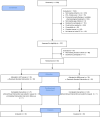A randomized controlled trial of supervised remotely-delivered attention bias modification for posttraumatic stress disorder
- PMID: 35132952
- PMCID: PMC10248784
- DOI: 10.1017/S003329172200023X
A randomized controlled trial of supervised remotely-delivered attention bias modification for posttraumatic stress disorder
Abstract
Background: Many individuals with posttraumatic stress disorder (PTSD) have limited access to first-line treatments, warranting the development of remotely-delivered treatments. Attention bias modification (ABM), targeting perturbed threat-related attentional patterns, shows promise when delivered in-person. However, previous studies found ABM to be ineffective when delivered remotely. Randomized clinical trials usually applied two variations of ABM: ABM away from threat or attention control training (ACT) balancing attention between threat-related and neutral stimuli. We tested remotely-delivered ACT/ABM with tighter supervision and video-based interactions that resemble in-clinic protocols. We expected to replicate the results of in-clinic trials, in which ACT outperformed ABM for PTSD.
Methods: In this double-blinded, parallel-group randomized controlled trial, 60 patients diagnosed with PTSD were randomized (ABM n = 30; ACT n = 30). Patients performed eight bi-weekly remotely-delivered supervised ABM/ACT sessions. Symptoms were assessed pre- and post-treatment with Clinician-Administered PTSD Scale 5 (CAPS-5) severity score and PTSD diagnosis as the primary outcomes. Current depressive episode, current anxiety-related comorbidity, and time elapsed since the trauma were examined as potential moderators of treatment outcome.
Results: Significant decrease in CAPS-5 severity scores and PTSD diagnosis was observed following both ACT and ABM with no between-group difference. Patients without depression or whose trauma occurred more recently had greater symptom reduction in the ACT than the ABM group.
Conclusions: Contrary to our expectation, symptoms decreased similarly following ACT and ABM. Moderator analyses suggest advantage for ACT in non-depressed patients and patients whose trauma occurred more recently. Further refinements in remotely-delivered ABM/ACT may be needed.
Keywords: Attention bias modification; posttraumatic stress disorder; randomized controlled trial; telemedicine.
Conflict of interest statement
None.
Figures



References
-
- American Psychiatric Association. (2013). Trauma- and Stressor-Related Disorders. In Diagnostic and statistical manual of mental disorders, fifth edition (pp. 265–290). Arlington, VA: American Psychiatric Association. 10.1176/appi.books.9780890425596.744053. - DOI
-
- Badura-Brack, A. S., Naim, R., Ryan, T. J., Levy, O., Abend, R., Khanna, M. M., … Bar-Haim, Y. (2015). Effect of attention training on attention bias variability and PTSD symptoms: Randomized controlled trials in Israeli and U.S. Combat Veterans. American Journal of Psychiatry, 172(12), 1233–1241. 10.1176/appi.ajp.2015.14121578. - DOI - PMC - PubMed
-
- Bardeen, J. R., Tull, M. T., Daniel, T. A., Evenden, J., & Stevens, E. N. (2016). A preliminary investigation of the time course of attention bias variability in posttraumatic stress disorder: The moderating role of attentional control. Behaviour Change, 33(2), 94–111. 10.1017/bec.2016.5. - DOI
Publication types
MeSH terms
Grants and funding
LinkOut - more resources
Full Text Sources
Medical
Miscellaneous

